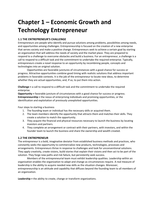Summary
Summary of Technology Ventures - Byers, Dorf & Nelson - Entrepreneurship - University of Twente - International Business Administration - I&E module
- Course
- Institution
- Book
Summary of the book Technology Ventures - Byers, Dorf & Nelson. Originally, the summaries were written for Entrepreneurship, University of Twente, I&E-module. The summary consists of the following chapters: 1,2,5,9,11,15,16.
[Show more]













